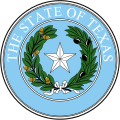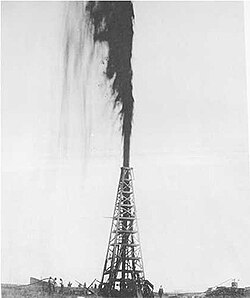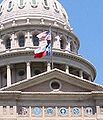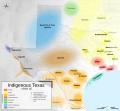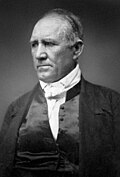Portal:Texas
The Texas Portal
Texas (/ˈtɛksəs/ ⓘ TEK-səss, locally also /ˈtɛksɪz/ TEK-siz; Spanish: Texas or Tejas, pronounced [ˈtexas]) is the most populous state in the South Central region of the United States. It borders Louisiana to the east, Arkansas to the northeast, Oklahoma to the north, New Mexico to the west, and has an international border with the Mexican states of Chihuahua, Coahuila, Nuevo León, and Tamaulipas to the south and southwest. Texas has a coastline on the Gulf of Mexico to the southeast. Covering 268,596 square miles (695,660 km2), the state has over 31 million residents as of 2024, and it is the second-largest state by area and population. Texas is nicknamed the Lone Star State for its former status as an independent republic, the Republic of Texas. Spain was the first European country to claim and control Texas. Following a short-lived colony controlled by France, Mexico controlled the land until 1836 when Texas won its independence, becoming the Republic of Texas. In 1845, Texas joined the United States of America as the 28th state. The state's annexation set off a chain of events that led to the Mexican–American War in 1846. Following victory by the United States, Texas remained a slave state until the American Civil War, when it declared its secession from the Union in early 1861 before officially joining the Confederate States of America on March 2. After the Civil War and the restoration of its representation in the federal government, Texas entered a long period of economic stagnation. Historically, five major industries shaped the Texas economy prior to World War II: cattle, bison, cotton, timber, and oil. Before and after the Civil War, the cattle industry—which Texas came to dominate—was a major economic driver and created the traditional image of the Texas cowboy. In the later 19th century, cotton and lumber grew to be major industries as the cattle industry became less lucrative. Ultimately, the discovery of major petroleum deposits (Spindletop in particular) initiated an economic boom that became the driving force behind the economy for much of the 20th century. Texas developed a diversified economy and high tech industry during the mid-20th century. As of 2024[update], it has the second-highest number (52) of Fortune 500 companies headquartered in the United States. With a growing base of industry, the state leads in many industries, including tourism, agriculture, petrochemicals, energy, computers and electronics, aerospace, and biomedical sciences. Texas has led the U.S. in state export revenue since 2002 and has the second-highest gross state product. (Full article...) Selected article -The Second Battle of Sabine Pass (September 8, 1863) was a failed Union Army attempt to invade the Confederate state of Texas during the American Civil War. The Union Navy supported the effort and lost three gunboats during the battle, two captured and one destroyed. It has often been credited as the war's most one-sided Confederate victory. Confederate President Jefferson Davis wrote in 1876 that he "considered the [second] battle of Sabine pass the most remarkable in military history." (Full article...) Selected biography -Lyndon Baines Johnson (/ˈlɪndən ˈbeɪnz/; August 27, 1908 – January 22, 1973), also known as LBJ, was the 36th president of the United States, serving from 1963 to 1969. He became president after the assassination of John F. Kennedy, under whom he had served as the 37th vice president from 1961 to 1963. A Southern Democrat, Johnson previously represented Texas in Congress for over 23 years, first as a U.S. representative from 1937 to 1949, and then as a U.S. senator from 1949 to 1961. Born in Stonewall, Texas, Johnson worked as a teacher and a congressional aide before winning election to the U.S. House of Representatives in 1937. In 1948, he was controversially declared the winner in the Democratic primary for the U.S. Senate election in Texas before winning the general election. He became Senate majority whip in 1951, Senate Democratic leader in 1953 and majority leader in 1954. Senator Kennedy bested Johnson and his other rivals for the 1960 Democratic presidential nomination before surprising many by offering to make Johnson his vice presidential running mate. The Kennedy–Johnson ticket won the general election. Vice President Johnson assumed the presidency in 1963, after President Kennedy was assassinated. The following year, Johnson was elected to the presidency in a landslide, winning the largest share of the popular vote for the Democratic Party in history, and the highest for any candidate since the advent of widespread popular elections in the 1820s. (Full article...) Texas news
Wikinews Texas portal
ListsState symbols
Texas topicsSelected imageCities -Dallas (/ˈdæləs/ ⓘ) is a city in the U.S. state of Texas and the most populous city in the Dallas–Fort Worth metroplex, the most populous metropolitan area in Texas and the fourth-most populous metropolitan area in the United States at 7.5 million people. It is the most populous city in and seat of Dallas County, covering nearly 386 square miles into Collin, Denton, Kaufman, and Rockwall counties. With a 2020 census population of 1,304,379, it is the ninth-most populous city in the U.S. and the third-most populous city in Texas after Houston and San Antonio. Located in the North Texas region, the city of Dallas is the main core of the largest metropolitan area in the Southern United States and the largest inland metropolitan area in the U.S. that lacks any navigable link to the sea. Dallas and nearby Fort Worth were initially developed as a product of the construction of major railroad lines through the area allowing access to cotton, cattle, and later oil in North and East Texas. The construction of the Interstate Highway System reinforced Dallas's prominence as a transportation hub, with four major interstate highways converging in the city and a fifth interstate loop around it. Dallas then developed as a strong industrial and financial center and a major inland port, due to the convergence of major railroad lines, interstate highways, and the construction of Dallas Fort Worth International Airport, one of the largest and busiest airports in the world. In addition, Dallas Area Rapid Transit (DART) operates rail and bus transit services throughout the city and its surrounding suburbs. (Full article...) General imagesThe following are images from various Texas-related articles on Wikipedia.
CategoriesSelect [►] to view subcategories
Related pages
Attractions
 Things you can doAssociated WikimediaThe following Wikimedia Foundation sister projects provide more on this subject:
SourcesMore portals | ||||||||||||||||||||||||||||||||||||||||


